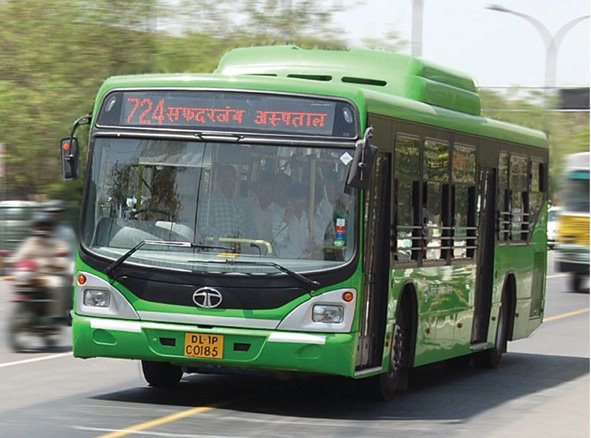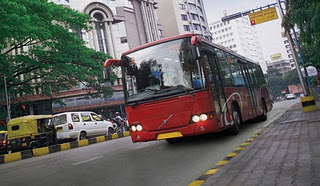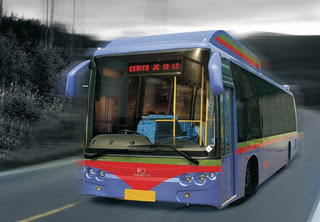
That’s why I believe that in India much of the action will happen in the bus industry particularly in the city bus segment. For example, the Delhi Transport Corporation (DTC) order has attracted the attention of global bus manufacturers and system suppliers. For the first time, significant bus orders have been executed with high technology aggregates and features like air suspension systems, automatic transmission, CAN systems, electronic display boards, GPS and electronic on-board ticketing.
DTC plans to add an estimated 8,000 buses to its fleet before the Commonwealth Games 2010 and is likely to spend Rs. 4,000 crores on the project. Tata Motors won the first contract to supply 500 low floor buses to DTC last year.
It is not just that DTC but all major city transport corporations, including Bangalore, Mumbai, Hyderabad, Chennai and Pune, are gearing up to improve the public transportation system. In fact it is projected that during the 11th Plan at least 26,000 buses would need to be replaced every year. So far, bus-based systems have been neglected in the country. But with newer technologies and increased availability of world-leading technology, India is at the cusp of developing highly successful urban mass transport systems. The existing fleet should be replaced with ergonomically designed buses, having wider doors and windows with level boarding and alighting, comfortable seats and suspension and equipped with public address system and ITS-enabled and vehicle tracking systems. Also if issues of pollution, global warming, environment, traffic have to be addressed, the public mode of transportation needs to step up and provide facilities that people need and want. With the advancements in technology propelling them in that direction, these buses are trying to do just that.
To cope up with the huge demand for buses, the Planning Commission has suggested delicensing of investment, lifting of quantitative restrictions (QRs) on imports, reduction in peak customs duty rates and in the recent budget has reduced the excise duty on buses chassis and bus body  building. The Government is taking up the Bus Rapid Transit System (BRTS) under the Jawaharlal Nehru National Urban Renewal Mission (JNNURM) as a cost-effective solution for providing high quality public transport service in urban areas. Nearly 16 Indian cities are also exploring the possibility of introducing BRTS.
building. The Government is taking up the Bus Rapid Transit System (BRTS) under the Jawaharlal Nehru National Urban Renewal Mission (JNNURM) as a cost-effective solution for providing high quality public transport service in urban areas. Nearly 16 Indian cities are also exploring the possibility of introducing BRTS.
DTC has recently invited bids for supply of 750 non-AC and 250 semi low floor city buses with CNG engines. This is in addition to the tender which was opened in January 2008 for 1,500 non-AC and 1,000 AC low-floor city buses. Bus manufacturers are rushing to meet the specifications of DTC.
DTC is planning to upgrade its complete city bus fleet with a combination of semi- and low-floor, air-conditioned and non air-conditioned buses by 2009. Similar fleet enhacements are taking place in Mumbai, Bangalore and Chennai. Bangalore recently placed an order with Volvo for 240 city buses and MTC, Chennai added/replaced nearly 2000 buses.
Commercial vehicle manufacturers in India are currently expanding aggressively, building capacity and entering into joint ventures with foreign bus makers as the Indian market readies for better roads and longer commutes, with State Governments looking to improve urban infrastructure. In the recently held Auto Expo, Indian bus manufacturers have showcased a range of buses, which are intelligent, innovative, comfortable, economic and safe. Ashok Leyland, Tata Motors and Volvo aim to revolutionize buses so that people can re-evaluate their options on public mode of transportation.
Leading the way is Volvo, which has changed the way people perceive bus travel in the country. Volvo city buses have provided sustainable public transport solutions that has kept pace with the rapid development and growth our cities face. Volvo City Buses are running in Bangalore, Chennai, Pune, Mysore. These are low-floor, AC buses meant for day-to-day travelling in cities. The aim is to provide people with a public mode of transportation which is safe, economic, comfortable and makes them chose a bus over a two-wheeler, a three-wheeler or a car. Volvo recently received an order for 240 buses from BMTC, Bangalore.
Tata Motors has done wonders to its bus portfolio. The company’s joint venture with Marcopolo has helped in clinching the first landmark order of supplying 525 low floor city buses to the Delhi Transport Corporation, in 2007. Ashok Leyland, recently showcased its feature filled concept intra-city ‘iBUS’ which has created lot of excitement amongst transport corporation. The company has conducted a series of road shows all across India showcasing the bus to all the major transport corporation and the response, the company says, has been overwhelming. Commercial production of these buses will start by end of this year.
Some media reports also indicate that Ashok Leyland has developed a low floor city jointly with Chinese bus manufacturer Foton mainly to cater to the orders from transport corporations of major metros. Chandigarh-based Cerita Motors, an independent bus manufacturer, has bagged major orders from Mumbai and Gurgaon City Transport Corporation.
All these clearly indicate the fact that the Indian bus industry is on the verge of exponential growth in the coming years.